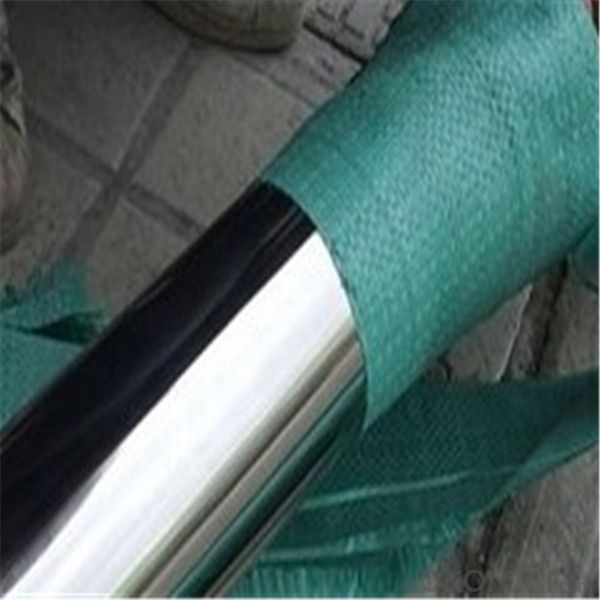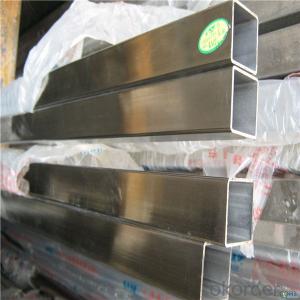Sch40 Stainless Steel Pipe TP304 316 316L in Wuxi ,China
- Loading Port:
- Shanghai
- Payment Terms:
- TT OR LC
- Min Order Qty:
- 2 m.t.
- Supply Capability:
- 25000 m.t./month
OKorder Service Pledge
OKorder Financial Service
You Might Also Like
Item specifice
316 stainless steel pipe
Product Description
Item | Sch40 stainless steel pipe TP304 316 316L |
Standard | ASTMA312,A213,A376,A789,A790,A376,A249, EN10217-7-2005,GB14976-2002,GB13296-2009, JIS G3459-2004,JIS3463-2006 |
Technique | cold rolled,hot rolled ,cold drawn |
Outside diameter | DN10-DN1200,3/8"-100",6-2500mm |
Wall thickness | SCH5-SCH160,XS,STD,XXS,0.5-150mm |
Length | 5.8m,6m,11.8m,12m,or as required |
Surface | Annealing,picking,polished,bright,hair line,brush,sand blast,stain finish,etc |
Price term | Ex-Work,FOB,CNF,CFR,CIF,FCA,DDP,DDU.etc |
Payment term | TT,L/C,western Union |
Export to | Ireland,Singapore,Indonesia,Ukraine,Saudi Arabia,Spain,Canada,USA,Brazil,Thailand, Malaysia,Chile,Korea,Iran,India,Egypt,Malaysia, Viet Nam,Oman,Dubai,Holland, Mexico,Peru,Italy,Russia,Nigeria,etc |
Package | Standard export package,suit for all kinds of transport, or as required |
Container Size | 20ft GP:5898mm(Length)x2352mm(Width)x2393mm(High),20-25 Metric ton 40ft GP:12032mm(Length)x2352mm(Width)x2393mm(High),20-25 Metric ton 40ft HC:12032mm(Length)x2352mm(Width)x2698mm(High),20-25 Metric ton |
Application | widely used in petroleum, foodstuff, chemical industry, construction,electric power, nuclear energy,biotechnology, machinery, paper making,shipbuilding,boiler fields etc |
Contact | If you have any question,please feel free to contact me . We are sure your inquiry or requirements will get prompt attention. |
Definition of stainless steel(Adopted form Wikipedia)
In metallurgy, stainless steel, also known as inox steel or inox from French "inoxydable",
is defined as a steelalloy with a minimum of 10.5% to 11% chromium content by mass.
Stainless steel does not readily corrode, rust or stain with water as ordinary steel does,
but despite the name it is not fully stain-proof, most notably under low oxygen, high salinity,
or poor circulation environments. It is also called corrosion-resistant steel or CRES
when the alloy type and grade are not detailed, particularly in the aviation industry.
There are different grades and surface finishes of stainless steel to suit the environment
the alloy must endure. Stainless steel is used where both the properties of steel
and resistance to corrosion are required.
Surface Finish :
Surface finish | Characteristics and application |
No.2B | The surface brightness and flatness of no2B is better than no2D. then through a special surface treatment to improve its mechanical properties, No2B could nearly satisfy comprehensive uses. |
No.3 | Polished with abrasive belt of git#100-#200, have better brightness with discontinuous coarse stria, used as inner and external ornaments for building, electrical appliances and kitchen utensils etc. |
No.4 | Polished with abrasive belt of grit #150-#180,have better brightness with discontinuous coarse stria, but thinner than No3, are used as bathtub buildings inner and external ornaments electrical appliances kitchen utensils and food processing equipment etc. |
HL | Polished with abrasive belt of grit #150-#320 on the NO.4 finish and has continuous streaks, mainly used as buildings ornaments elevators, door of building, frontal plate etc. |
BA | Cold rolled, bright annealed and skin-passed, the product have excellent brightness and good reflexivity like mirror, kitchen apparatus, ornament etc. |
8K | The product have excellent brightness and prefer reflexivity can to be the mirror. |


- Q:How do you prevent noise transmission in stainless steel pipes?
- To prevent noise transmission in stainless steel pipes, various measures can be taken. One effective method is to use acoustic insulation materials, such as foam or rubber, to wrap around the pipes. This helps absorb and dampen the sound waves, reducing noise transmission. Additionally, installing vibration isolators or flexible pipe connectors at connecting points can minimize the transfer of vibrations and noise. Properly securing the pipes and ensuring they are properly supported can also help prevent noise transmission by reducing any rattling or vibrations.
- Q:What are the common types of fittings used with stainless steel pipes?
- The common types of fittings used with stainless steel pipes include butt-weld fittings, socket-weld fittings, threaded fittings, and compression fittings. These fittings ensure secure connections between stainless steel pipes, allowing for efficient and reliable fluid or gas flow.
- Q:Can stainless steel pipes be fabricated?
- Yes, stainless steel pipes can be fabricated.
- Q:How do you insulate stainless steel pipes?
- One way to insulate stainless steel pipes is by using insulation materials such as foam pipe covers or fiberglass pipe insulation. These materials can be wrapped around the pipes to provide a layer of insulation and prevent heat loss or condensation. Additionally, using insulation tape or adhesive can help secure the insulation in place.
- Q:Are stainless steel pipes suitable for abrasive media?
- Yes, stainless steel pipes are suitable for abrasive media. Stainless steel is known for its high strength and corrosion resistance, making it an ideal material for handling abrasive substances. The smooth surface of stainless steel pipes helps to reduce friction and minimize wear and tear caused by abrasive particles. Additionally, stainless steel pipes can withstand high pressures and temperatures, making them suitable for various industrial applications where abrasive media is involved, such as mining, chemical processing, and wastewater treatment. Overall, stainless steel pipes are a reliable and durable choice for transporting abrasive media.
- Q:What is the difference between seamless and SAW stainless steel pipes?
- Seamless and SAW (Submerged Arc Welding) stainless steel pipes find utility in various industries for the transportation of fluids or gases, but they possess certain distinct dissimilarities. 1. Manufacturing Process: The primary discrepancy resides in their manufacturing processes. Seamless stainless steel pipes emerge from the piercing of a solid billet, shaping it into a hollow tube. Conversely, SAW pipes result from the welding of multiple layers of steel plates together, employing a submerged arc welding technique. 2. Appearance: Seamless pipes boast a sleek and polished surface, imparting them with a more visually pleasing aspect. Conversely, SAW pipes display discernible welding seams, which can manifest internally or externally. 3. Strength and Durability: Seamless pipes generally exhibit superior strength and durability compared to SAW pipes. The absence of welding seams in seamless pipes eradicates potential weak points, rendering them less prone to failure under elevated pressure or extreme temperatures. 4. Size Range: Seamless pipes offer a broader spectrum of sizes, encompassing both small and large diameters. SAW pipes, limited by the welding process, are primarily employed for larger diameter pipes. 5. Cost: In terms of cost-effectiveness, SAW pipes typically hold an advantage over seamless pipes. The manufacturing process of SAW pipes entails the welding of multiple plates, which is less expensive than the process of creating a seamless pipe from a solid billet. 6. Applications: Seamless pipes find common usage in industries where high pressure and corrosion resistance are imperative, such as oil and gas, petrochemical, and power generation. SAW pipes, owing to their larger size range and cost-effectiveness, are frequently utilized in infrastructure projects like water supply, sewage systems, and construction. In conclusion, the principal discrepancies between seamless and SAW stainless steel pipes lie in their manufacturing process, appearance, strength, size range, cost, and applications. The choice between the two hinges upon the specific requirements of the project and the desired characteristics of the pipe.
- Q:How do you prevent galvanic corrosion in stainless steel pipes?
- To prevent galvanic corrosion in stainless steel pipes, it is crucial to avoid direct contact with dissimilar metals. This can be achieved by using appropriate insulation or protective coatings on the pipes, ensuring that they do not come into contact with materials such as copper or aluminum. Additionally, employing dielectric unions or isolating gaskets at the connection points can help to minimize the risk of galvanic corrosion. Regular maintenance, including inspection and cleaning, is also essential to identify and address any potential issues before they escalate.
- Q:What are the factors to consider when selecting a stainless steel pipe for a specific application?
- When selecting a stainless steel pipe for a specific application, there are several factors to consider. These factors include the required corrosion resistance, temperature and pressure requirements, the type of fluid or gas being transported, the pipe size and thickness, the desired strength and durability, and any specific industry standards or regulations that need to be followed. Additionally, the cost, availability, and ease of installation should also be taken into account. Overall, it is important to carefully evaluate these factors to ensure that the chosen stainless steel pipe is suitable for the intended application.
- Q:What wire is used for welding of 316 stainless steel line?
- Apply A102 (E308-16) or A202 (E316-16) welding rodAttention should be summarized as follows: welding rod should be dry, low current, fast welding speed, interlayer temperature of about 60 degrees, intermittent welding, in order to avoid intergranular corrosion, immediately after welding water cooling.
- Q:Are stainless steel pipes resistant to scaling?
- Yes, stainless steel pipes are highly resistant to scaling.
1. Manufacturer Overview |
|
|---|---|
| Location | |
| Year Established | |
| Annual Output Value | |
| Main Markets | |
| Company Certifications | |
2. Manufacturer Certificates |
|
|---|---|
| a) Certification Name | |
| Range | |
| Reference | |
| Validity Period | |
3. Manufacturer Capability |
|
|---|---|
| a)Trade Capacity | |
| Nearest Port | |
| Export Percentage | |
| No.of Employees in Trade Department | |
| Language Spoken: | |
| b)Factory Information | |
| Factory Size: | |
| No. of Production Lines | |
| Contract Manufacturing | |
| Product Price Range | |
Send your message to us
Sch40 Stainless Steel Pipe TP304 316 316L in Wuxi ,China
- Loading Port:
- Shanghai
- Payment Terms:
- TT OR LC
- Min Order Qty:
- 2 m.t.
- Supply Capability:
- 25000 m.t./month
OKorder Service Pledge
OKorder Financial Service
Similar products
New products
Hot products
Hot Searches
Related keywords


























